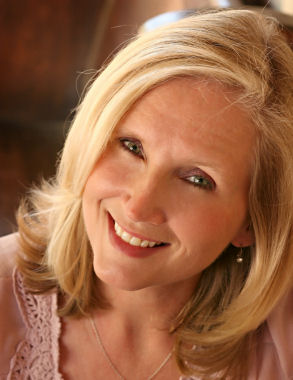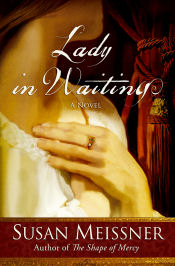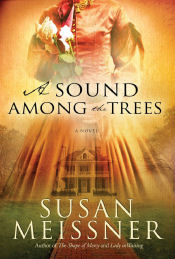|
 Susan Meissner has enjoyed life
to the full: a military spouse, a pastor’s wife, and a writer. Each day
she searches life, history, and faith, seeking the story God wants her
to share. She is not afraid of difficult themes or potentially
confrontational story lines, and her readers are faithful to share
their hearts with her on both! Susan has just released a story dealing
with issues of addiction and mental illness, and she is working on a
story that explores what happens when a disillusioned travel-book
editor meets a delusional memoir writer! So join her on the journey,
won’t you? It promises to be a great ride! Susan Meissner has enjoyed life
to the full: a military spouse, a pastor’s wife, and a writer. Each day
she searches life, history, and faith, seeking the story God wants her
to share. She is not afraid of difficult themes or potentially
confrontational story lines, and her readers are faithful to share
their hearts with her on both! Susan has just released a story dealing
with issues of addiction and mental illness, and she is working on a
story that explores what happens when a disillusioned travel-book
editor meets a delusional memoir writer! So join her on the journey,
won’t you? It promises to be a great ride!
Susan, the
testimony of your path to publication is very interesting! Tell us some
of the highlights of your journey and how your career now compares with
your writing at the beginning.
Sometimes I’ll wonder if I’ve
made all the right career decisions since I wrote my first novel in
2003. But whenever I ponder what I might’ve done differently, I’m
always staggered by the notion that I might not have made the same
friends if I hadn’t had the same journey. Most definitely the highlight
of the last eight years has been the friends I’ve made. I had no idea
that my relationships with people I may see only once a year or less
would be the richest part of my writing life.
 Other highlights have
been the starred reviews in Publishers Weekly, the
ECPA book of the year award and the Christy nomination. I’ve never been
on a best-seller list, and to be honest, sometimes it’s hard to put
everything I’ve got into a book and then not see an apples-to-apples
return on that investment of time, trouble, and mental gymnastics.
Affirmation can come from sources other than best-seller lists, though,
and I am grateful that what the industry calls critical acclaim is a
way of saying I am doing what I want most to do: tell a good story. Other highlights have
been the starred reviews in Publishers Weekly, the
ECPA book of the year award and the Christy nomination. I’ve never been
on a best-seller list, and to be honest, sometimes it’s hard to put
everything I’ve got into a book and then not see an apples-to-apples
return on that investment of time, trouble, and mental gymnastics.
Affirmation can come from sources other than best-seller lists, though,
and I am grateful that what the industry calls critical acclaim is a
way of saying I am doing what I want most to do: tell a good story.
In the beginning of my career, I
was bursting with untold stories, and I wrote like lava out of a
volcano. These days I am more of a gentle stream writer. The words come
more slowly and I fight for them more than I did in the beginning, when
it seemed like there was no hunt; I just grabbed and spilled. Today,
the perfect page is more elusive and I linger over how to express what
I see in my head. It makes the catch that much sweeter.
You have
written many stories that deal with uncomfortable topics ranging from
an unanticipated/ unwanted pregnancy to the death of a parent. A lot of
times you weave contemporary, timeless themes with a historical theme
or element. How did you come to this style of writing? Is it the way
you explore subjects that dramatically affect lives? Is it the way you
explore your own faith?
These last few years I have been
intrigued by events in human history, like the Salem witch trials, and
the Warsaw Ghetto during WW II, Lady Jane Grey, and the idea that there
are things about us that don’t change from century to century, such as
what we hold most precious and what we fear the most. When I come
across something in the past that has story value to the present, I
start stretching the idea to see how a present-day situation could be
influenced by an unforgettable moment in the past. Usually when I come
across a poignant or pivotal moment in history, something about it
speaks to us right now.
There is, of course, that
tried-and-true maxim that if we don’t learn from history we’re doomed
to repeat it. I don’t know if that is always true, but I do believe
that if we don’t learn from history, we’ve missed out on a free life
lesson without any personal heartache. I think that’s one reason God
has filled the Bible with historical accounts. First, to show us His
character, holiness, and limitless love, but also to show us how to
live life and how not to live it. For example, if I’m ever approached
by a talking serpent encouraging me to disobey the God who loves me,
I’m going to smash it with a hammer.
Your latest
novel, A Sound Among the Trees, is based on a true
story, and I’m assuming it’s the story surrounding the house featured
in the story. You include the very contemporary theme of addiction. How
did you discover this story? How did you research addiction, and how
were you inspired to incorporate that into a Civil War baseline?

Actually, what is true in A
Sound Among the Trees is the battle that took place in 1862
in Fredericksburg, Virginia. The rest of the story is my fictive dream
on paper. The house looks like one that I saw in Fredericksburg when I
was there on a research trip, but I took a lot of liberties with it
because Holly Oak, the house in this book, needed to come across as a
character, so I needed to have free reign with it. The addiction was
really more a symptom of a bigger problem, which for this fictional
family was mental illness. Many times substance abuse is an indicator
of a huge, underlying problem.
I didn’t spend hours of research
on types of mental illness, but I did spend oodles of hours on how
ordinary people were affected
|
by
the ravages of this war. The Civil War
was unlike any other battle our nation has fought. We weren’t fighting
some foreign enemy. We were fighting one another over ideologies. But
everyone still bled and died and suffered like it was a land war. The
emotional toll was heavy.
A
Sound Among the Trees also includes references to some
supernatural perception, which was a little edgy (one character was
confident of her ability to communicate with the dead,) yet it fit
beautifully with the spiritual transformation that takes place in the
life of one of the main characters. Was it easy or difficult to write
about that?
Without spoiling anything for
anyone, I will say that it really wasn’t hard to write because there is
no ghost, and no one can convince me that we have the power or the
right to contact the dead, nor have I seen any evidence that the dead
have the ability to walk the earth. That one character you mention is,
like you say, confident of her so-called abilities, but misguided
people are everywhere. The take-away here is that there is very
definitely a spiritual realm on earth. We live in the physical, but  the spiritual is all around us. We
don’t see it, just like we don’t see God, but the Bible is clear that
this realm we can’t see is real. What this family at Holly Oak was
afraid of was truth, and they treated it like a specter they didn’t
have the courage or the motivation to face. They made their own ghost
with their fear and hanging on to the past. the spiritual is all around us. We
don’t see it, just like we don’t see God, but the Bible is clear that
this realm we can’t see is real. What this family at Holly Oak was
afraid of was truth, and they treated it like a specter they didn’t
have the courage or the motivation to face. They made their own ghost
with their fear and hanging on to the past.
What has the
reader response been to A Sound Among the Trees?
Anything that has particularly touched you? Surprised you?
I am always amazed when a reader
writes to tell me they have had a major breakthrough when they’ve read
something of mine. When a reader wrote to tell me that she finally
realized how much she was letting the past dictate her present after
reading this book, I was naturally humbled to my core.
And I was somewhat surprised by
a review, a rather negative one, in which the reviewer was disappointed
I didn’t have God front and center in the story. I guess this person
thought that since my book is “Christian fiction,” God needed to be a
character in the story and everyone in the cast needed to be Christians
or at least becoming so by the last page.
Tell us about
your current project and when readers can expect another story from
your pen.
I just sent my latest
book project to my editor at WaterBrook, a novel called The
Girl in the Glass, which will hit shelves this time next
year. Here’s the plot in a nutshell: Meg Pomeroy, a thirty-year-old
travel-book editor, is emotionally fed up after a broken engagement,
the disappearance of her irresponsible father, the loss of a promised
heirloom painting, and the knowledge that her perennially cautious
mother is now dating a man half her age and whom Meg finds herself
desperately attracted to. When her missing father sends her a ticket to
Florence, Italy, where he’d promised he would take her, Meg assumes he
will meet her there, but she arrives alone. Disillusioned, she turns to
a Florentine brother and sister writing team she knows only through
work. They introduce her to Sofia, a memoir writer who claims she’s the
last Medici and that the masterpieces of the Italian Renaissance speak
to her. What happens when a disillusioned travel-book editor meet a
delusional memoir writer? Stick around and I’ll show you! And, by the
way, there’s a lot of Florence in this book.
As a pastor’s
wife and former military spouse, do you find yourself with an endless
supply of story ideas? How are you most often inspired—from life,
history, or both?
I used to have an endless
supply! Now it seems like I have to look harder and I definitely think
it’s a combination of both life and history that inspires me. I usually
find ideas when I am not looking for them. In fact, I would say it’s
happened that way every time I’ve written a book. The idea came when I
wasn’t looking for it.
What is the
most exciting thing you have learned about your own faith in the recent
past?
I just finished reading Ann
Voskamp’s One Thousand Gifts and I’ve realized that
my faith is largely based on future blessings. I am learning to
recalibrate my view on what God is doing in my life and what He gives
and takes. I am learning that thanksgiving is the key to everything. It
really is. Thanksgiving for the now: for what I have right now and what
I don’t have right now.
What are you
most excited about as you face a new year of ideas and storytelling?
I am looking forward to digging
deeper into what makes us human and therefore partially divine. We have
been created in God’s image; that makes us like Him in ways I don’t
think I have fully explored yet. And I think it’s that bit of the
divine in us that makes Story such an amazing vehicle for contemplating
how we are like Him. And of course, how we aren’t. There you go. That’s
the tension of every great story.

Kim
Ford has been a resident of
Alabama for more than ten years. Originally from Georgia, she holds a
Bachelor’s degree in English from Brenau Women’s College. She has spent
the past 9 years in sales and marketing and has been an avid reader of
Christian Fiction for more than 20 years.
A mother of two teen sons and married to a technical writer and Army
veteran, Kim’s life is full and blessed. She and her husband also
volunteer as teachers for a resident rehab program for women with
life-controlling issues. She uses her fiction to encourage the ladies
she teaches. She blogs at: Window
To My World
|